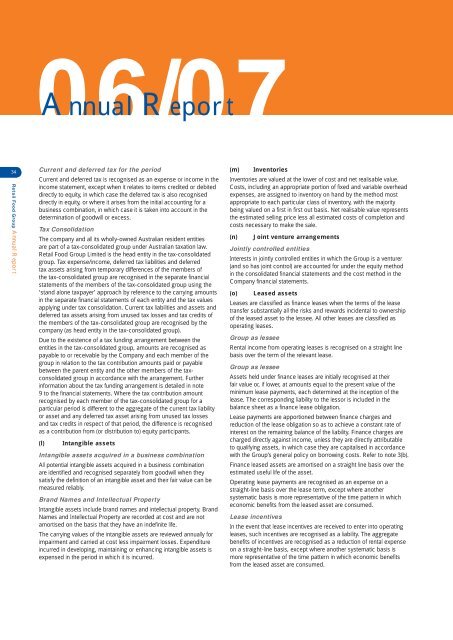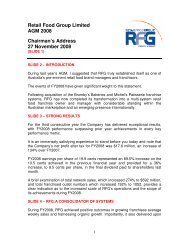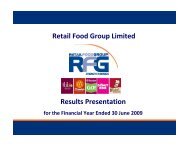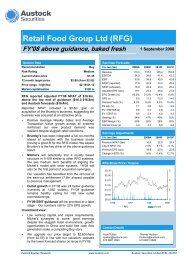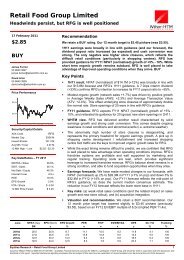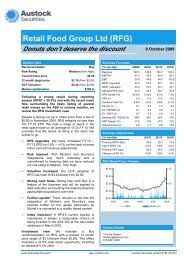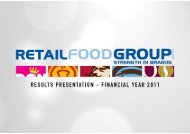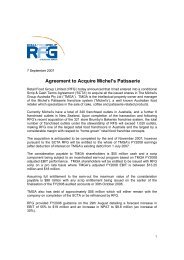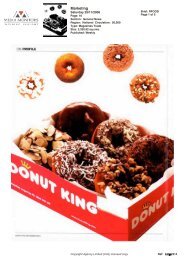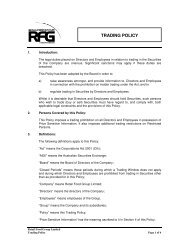RFG Annual Report 2007 - Retail Food Group
RFG Annual Report 2007 - Retail Food Group
RFG Annual Report 2007 - Retail Food Group
You also want an ePaper? Increase the reach of your titles
YUMPU automatically turns print PDFs into web optimized ePapers that Google loves.
06/07<br />
<strong>Annual</strong> <strong>Report</strong><br />
34<br />
<strong>Retail</strong> <strong>Food</strong> <strong>Group</strong> <strong>Annual</strong> <strong>Report</strong><br />
Current and deferred tax for the period<br />
Current and deferred tax is recognised as an expense or income in the<br />
income statement, except when it relates to items credited or debited<br />
directly to equity, in which case the deferred tax is also recognised<br />
directly in equity, or where it arises from the initial accounting for a<br />
business combination, in which case it is taken into account in the<br />
determination of goodwill or excess.<br />
Tax Consolidation<br />
The company and all its wholly-owned Australian resident entities<br />
are part of a tax-consolidated group under Australian taxation law.<br />
<strong>Retail</strong> <strong>Food</strong> <strong>Group</strong> Limited is the head entity in the tax-consolidated<br />
group. Tax expense/income, deferred tax liabilities and deferred<br />
tax assets arising from temporary differences of the members of<br />
the tax-consolidated group are recognised in the separate fi nancial<br />
statements of the members of the tax-consolidated group using the<br />
‘stand alone taxpayer’ approach by reference to the carrying amounts<br />
in the separate fi nancial statements of each entity and the tax values<br />
applying under tax consolidation. Current tax liabilities and assets and<br />
deferred tax assets arising from unused tax losses and tax credits of<br />
the members of the tax-consolidated group are recognised by the<br />
company (as head entity in the tax-consolidated group).<br />
Due to the existence of a tax funding arrangement between the<br />
entities in the tax-consolidated group, amounts are recognised as<br />
payable to or receivable by the Company and each member of the<br />
group in relation to the tax contribution amounts paid or payable<br />
between the parent entity and the other members of the taxconsolidated<br />
group in accordance with the arrangement. Further<br />
information about the tax funding arrangement is detailed in note<br />
9 to the fi nancial statements. Where the tax contribution amount<br />
recognised by each member of the tax-consolidated group for a<br />
particular period is different to the aggregate of the current tax liability<br />
or asset and any deferred tax asset arising from unused tax losses<br />
and tax credits in respect of that period, the difference is recognised<br />
as a contribution from (or distribution to) equity participants.<br />
(l)<br />
Intangible assets<br />
Intangible assets acquired in a business combination<br />
All potential intangible assets acquired in a business combination<br />
are identifi ed and recognised separately from goodwill when they<br />
satisfy the defi nition of an intangible asset and their fair value can be<br />
measured reliably.<br />
Brand Names and Intellectual Property<br />
Intangible assets include brand names and intellectual property. Brand<br />
Names and Intellectual Property are recorded at cost and are not<br />
amortised on the basis that they have an indefi nite life.<br />
The carrying values of the intangible assets are reviewed annually for<br />
impairment and carried at cost less impairment losses. Expenditure<br />
incurred in developing, maintaining or enhancing intangible assets is<br />
expensed in the period in which it is incurred.<br />
(m) Inventories<br />
Inventories are valued at the lower of cost and net realisable value.<br />
Costs, including an appropriate portion of fi xed and variable overhead<br />
expenses, are assigned to inventory on hand by the method most<br />
appropriate to each particular class of inventory, with the majority<br />
being valued on a fi rst in fi rst out basis. Net realisable value represents<br />
the estimated selling price less all estimated costs of completion and<br />
costs necessary to make the sale.<br />
(n)<br />
Joint venture arrangements<br />
Jointly controlled entities<br />
Interests in jointly controlled entities in which the <strong>Group</strong> is a venturer<br />
(and so has joint control) are accounted for under the equity method<br />
in the consolidated fi nancial statements and the cost method in the<br />
Company fi nancial statements.<br />
(o) Leased assets<br />
Leases are classifi ed as fi nance leases when the terms of the lease<br />
transfer substantially all the risks and rewards incidental to ownership<br />
of the leased asset to the lessee. All other leases are classifi ed as<br />
operating leases.<br />
<strong>Group</strong> as lessee<br />
Rental income from operating leases is recognised on a straight line<br />
basis over the term of the relevant lease.<br />
<strong>Group</strong> as lessee<br />
Assets held under fi nance leases are initially recognised at their<br />
fair value or, if lower, at amounts equal to the present value of the<br />
minimum lease payments, each determined at the inception of the<br />
lease. The corresponding liability to the lessor is included in the<br />
balance sheet as a fi nance lease obligation.<br />
Lease payments are apportioned between fi nance charges and<br />
reduction of the lease obligation so as to achieve a constant rate of<br />
interest on the remaining balance of the liability. Finance charges are<br />
charged directly against income, unless they are directly attributable<br />
to qualifying assets, in which case they are capitalised in accordance<br />
with the <strong>Group</strong>’s general policy on borrowing costs. Refer to note 3(b).<br />
Finance leased assets are amortised on a straight line basis over the<br />
estimated useful life of the asset.<br />
Operating lease payments are recognised as an expense on a<br />
straight-line basis over the lease term, except where another<br />
systematic basis is more representative of the time pattern in which<br />
economic benefi ts from the leased asset are consumed.<br />
Lease incentives<br />
In the event that lease incentives are received to enter into operating<br />
leases, such incentives are recognised as a liability. The aggregate<br />
benefi ts of incentives are recognised as a reduction of rental expense<br />
on a straight-line basis, except where another systematic basis is<br />
more representative of the time pattern in which economic benefi ts<br />
from the leased asset are consumed.


